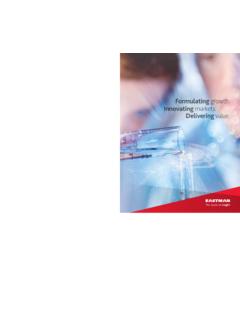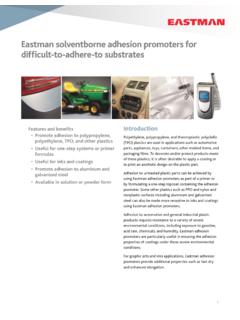Transcription of A-107G Bulk Storage and Handling of Acids and …
1 bulk Storage and handlingof Acids and anhydridesContentsBulk Storage and Handling of Acids and anhydrides 3 Introduction 3 Storage equipment 4 Tank construction materials 5 Piping 6 Pumps 6 Valves 6 Gaskets 6 Vents 6 Tank fi ll line 6 bulk unloading 7 Tank car unloading 7 Suggested unloading guidelines for tank cars 9 Tank trailer unloading 10 Suggested unloading guidelines for tank trailers 10 Safety precautions 11 Information 11 Protective clothing 11 Technical assistance 113 bulk Storage and Handling of Acids and anhydridesIntroductionThis publication provides information on Storage and Handling of Eastman Acids and anhydrides.
2 The drawings and discussions are for information only and should be used solely as a guide in developing procedures and facilities for Handling Eastman Acids and anhydrides listed below. Customers must determine for themselves the appropriate procedures and facilities for their AnhydridesAcetic Acetic Propionic Propionic n-Butyric n-Butyric Isobutyric Isobutyric 2-Ethylhexanoic The information in this publication, along with the data and information contained in Eastman s Material Safety Data Sheets (MSDS), needs to be reviewed and understood to help ensure safe Storage and Handling of Eastman Acids and anhydrides.
3 It is the customer s responsibility to direct and control the unloading of any chemical or material into or from bulk Storage and Handling facilities. Title to all chemicals or materials, unless otherwise specifi ed, shall vest in a customer at Eastman s shipping point. Federal, state, and local regulations regarding Handling and Storage of chemicals may vary widely. The Federal Occupational Safety and Health Administration (OSHA), Environmental Protection Agency (EPA), National Fire Protection Association (NFPA), and a user s insurance company also impose safety standards. In addition, the Department of Transportation (DOT) prescribes rules and regulations for unloading hazardous materials from tank cars and tank trailers (see 49 CFR 100-199).
4 Knowledge of these and other appropriate federal and state laws and regulations as well as consultation with the proper authority should provide guidance for developing adequate Handling procedures and constructing appropriate Storage and drumming contained herein constitutes a representation or warranty concerning the products, the attributes of the products, or the manner in which the products are to be safely or properly used, handled, stored, transported, or shipped. You are hereby notifi ed to seek independent advice on all such information, products, methods, apparatus, or services are provided as is without warranty of any kind.
5 Eastman hereby expressly disclaims any and all warranties regarding the products, methods, apparatus, services, and practices associated therewith, whether express or implied, including without limitation, any implied warranty of merchantability, fi tness for a particular purpose, title, and noninfringement. You assume the entire risk of relying on this information. In no event shall Eastman be responsible for damages of any nature whatsoever resulting from the use of or reliance on this information. By providing this information, Eastman neither can nor intends to control the method or manner by which you use, handle, store, or transport Eastman products.
6 4 Storage equipmentTank construction materials and facilities for tank car and tank trailer Handling of these materials are described and illustrated on the following pages. The drawings and discussions are for information only and should be used solely as a guide in storing and Handling these Eastman products. Customers/users must determine for themselves the appropriate Storage and Handling facilities for their operations in the country the location, fabrication, installation, inspection, and testing of acid and anhydride Storage tanks, the designer should refer to appropriate standards including the following: ANSI/NB-23 National Board Inspection CodeASME Boiler Pressure Code, Section VIII, Division 1 API Standard 510 Pressure Vessel Inspection Code: Maintenance, Inspection, Rating, Repair, and AlterationAPI Standard 570 Piping Inspection Code.
7 Inspection, Repair, Alteration, and Rerating of In-Service Piping SystemsAPI Standard 620 Design and Construction of Large, Welded, Low-Pressure Storage TanksAPI Standard 650 Welded Steel Tanks for Oil StorageAPI Standard 653 Tank Inspection, Repair, Alteration, and ReconstructionAPI Standard 2000 Venting Atmospheric and Low-Pressure Storage Tanks: Nonrefrigerated and Refrigerated29 CFR Flammable and Combustible LiquidsNFPA 30 Flammable and Combustible Liquids CodeBonding and grounding are important to inhibit the accumulation of static electricity and provide for its safe discharge. Bonding and grounding are required for all equipment, piping, tank cars, tank trailers, and interconnections.
8 Regarding bonding and grounding considerations, refer to the following and other appropriate standards: API RP 2003 Protection Against Ignitions Arising Out of Static, Lightning, and Stray CurrentsNFPA 77 Recommended Practice on Static ElectricityPotential electrical ignition hazards should be controlled through proper selection and installation of electrical equipment. The Storage , Handling , and unloading areas should be classified in accordance with the information available in the following standards and any other applicable standards for your area or 70 National Electrical CodeNFPA 497 Recommended Practice for the Classification of Flammable Liquids, Gases or Vapors and of Hazardous (Classified) Locations for Electrical Installations in Chemical Process AreasProper selection and installation of electrical equipment should be based on NFPA 70 in accordance with the area electrical classification.
9 Potential nonelectrical ignition hazards should be controlled through safe work processes and maintenance of Storage tanks and relief devices, it is recommended that the customer/user establish regular schedules for inspection of tanks, relief devices, and construction materialsStorage tanks should be constructed of 316L stainless steel. To reduce corrosion of the tank bottom exterior, a coating should be applied between the tank and vertical atmospheric Storage tank is shown in Figure 1. The Storage tank area should be enclosed by containment facilities capable of containing the contents of the tank and the maximum expected rainfall for an appropriate design storm event.
10 The enclosed area should be drained through a trap to a safe location that is protective of human health and the environment and is in compliance with applicable laws and regulations. A vertical tank provides a more economical use of land than does a horizontal outdoor Storage of glacial (anhydrous) acetic acid (freezing point C [ F]), a heating system and tank insulation should be provided. The recommended heating system consists of low-temperature electric heating pads installed between the tank exterior and the insulation that will maintain the temperature at a desirable level. Heating a point of the tank or pipe wall to a high temperature may result in accelerated corrosion at the point of heating.









